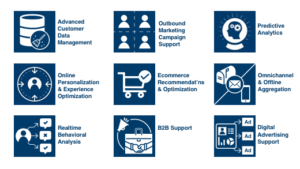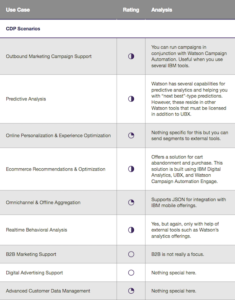Apply Business Use Cases to Evaluate CDPs
January 24, 2019When comparing or evaluating Customer Data Platforms, people tend to default to feature comparisons. This seems logical, but can risk missing the business forest for the technical trees.
For Real Story Group vendor evaluations, we do examine features, but focus more on business use cases, or “scenarios,” to find more meaningful contrasts for prospective enterprise technology customers. While you should always consider product functionality and vendor predilections, the key to comparing technologies lies in how well they fit your particular scenarios.
Nine CDP Scenarios
Explicitly or not, different CDP vendors target different scenarios. This is usually because the product’s flagship customers wanted to fulfill a specific subset of use cases. The platform might have broadened its scope as it matured, but typically the initial roots remain visible — and powerful.

Nine CDP Scenarios. Source: Real Story Group
In our recently-debuted CDP vendor evaluations (get free sample evaluation here), RSG isolated nine distinct business scenarios against which we assess platform fit. Some will be more or less germane to you. In some cases CDPs support a business capability, rather than deliver the service itself.
Vendors will of course claim broad applicability for their platforms, but we find in reality they typically specialize in three or four of the nine. Let’s look at each in turn.
1. Advanced Customer Data Management
This scenario might seem like an oxymoron because the primary purpose of a CDP is to provide data management services. But some vendors focus intently on this set of back-end capabilities, and less on the more activation-oriented services below. It’s a kind of purist approach, but your enterprise might want to focus here if you anticipate having to support multiple data sets, create virtualized data store, expect unusual challenges reconciling identities, anticipate using the data for non-marketing use cases, or have other advanced data munging needs.
2. Outbound Marketing Campaign Support
Support for outbound marketing campaigns is almost foundational and therefore, most CDPs enable this case in some form. However, the extent of that support varies. Some tools enable varying degrees of integration with outbound marketing and campaign platforms, most notably delivering segmented lists for activation. Other CDP vendors provide some inbuilt campaign capabilities to activate that data themselves, while others have built multi-step, journey orchestration features. Your mileage will vary.
3. Predictive Analytics
Predictive Analytics helps you answer hypothetical questions by predicting some aspect of an overall customer journey. CDP tools that offer this service will typically apply machine learning and artificial intelligence-based techniques. With time, and more data, the system is supposed to keep learning and improve its recommendations.
Of course, this also adds complexity to these platforms. Several CDPs can get you up and running within days, but most products that support predictive analytics will need you to do your homework well. Also, you may already possess more advanced predictive analysis services in other platforms and repositories (e.g., data lakes) within your organization that could prove more mature and adept at this.
4. Online Personalization & Experience Optimization
CDPs can potentially address two key dimensions of personalization:
- Understand Individuals: Gain a better understanding of customers, apply them to segments, and then…
- Personalize Experiences: Adapt content, options, and digital experiences based on that understanding
Most CDPs stop at the first dimension. They will integrate with downstream marketing / experience management / targeting systems for actual experience personalization — principally by pushing segments or individual records forward. Many large enterprises prefer this approach as it neatly separates data and experience concerns.
Some CDPs also offer built-in personalization engines. Also sometimes known as “recommender” systems, these platforms try to recommend content based on different attributes.
5. Ecommerce Recommendations & Optimization
Some CDPs offer specific services to target ecommerce scenarios. These include support for features to handle shopping cart abandonment, repeat purchases, next best offers, promotional campaigns, and so forth, leveraging diverse product attributes. These platforms typically feature tighter integration with common ecommerce environments, as well as heavier reliance on machine learning-based techniques for product recommendations. Here again let’s distinguish between providing the data for your ecommerce engine to act on and actually providing the recommendation service itself.
6. Omnichannel & Offline Aggregation
While most CDPs can handle data and campaigns for digital marketing, not all of them are as good for integrating the following types of data:
- Offline customer data from stores and point of sale (POS) terminals
- Data from mobile apps
- Data from other internet-connected devices such as Apple TV, gaming consoles, smartwear, and so on
Platforms that excel at this scenario offer at least some of these capabilities, along with services like managing physical address formats, and SDKs for different computing environments like IoT devices.
7. Realtime behavioral analysis
Most CDP vendors will claim they have machine learning capabilities. But very few can apply machine learning to streaming data in real time. CDPs that excel in this scenario offer more advanced algorithms that can work against existing data as well as live streaming data. Mind some significant architectural issues here around performance, reliability, and security.
8. B2B Marketing Support
In this environment, a company becomes a first-class object and not just a facet of an individual’s record. CDPs that support this scenario can map customers to an account or organization object and vice-versa. Then ideally other CDP services — like data integration, segmentation, and analytics — can get carried out at an account or organization level as well.
9. Digital Advertising Support
Adtech and martech are slowly converging. Most CDPs can integrate with DMPs and other tools to get second-party and third-party data which they can use to enrich their first-party data. A few platforms also provide specific capabilities for advertising scenarios by integrating with ad servers and other adtech platforms.
Putting Use Cases to Use
You can apply scenarios to find out what a CDP really does well…and not. Consider the case of IBM’s Universal Business Exchange (UBX). Many observers would argue it’s not really a CDP, though Big Blue will try to sell it to you as one. A deeper, scenario-based evaluation suggests that UBX is reasonably broad but not deep, and, importantly, relies on numerous other IBM platforms to achieve business value.

Evaluating IBM’s UBX as a CDP. Source: Real Story Group
Summing Up
To be sure, these scenarios are abstractions. In practice, your own efforts here are likely to represent variants or a hybrid combination of scenarios. The cases overlap somewhat, but they are useful for understanding what types of platforms tend to work better for different types of projects.
So a savvy customer will prioritize their needs and select technology accordingly from among the dozens of choices in front of you. Feel free to ping me with any questions or leave a comment below.


